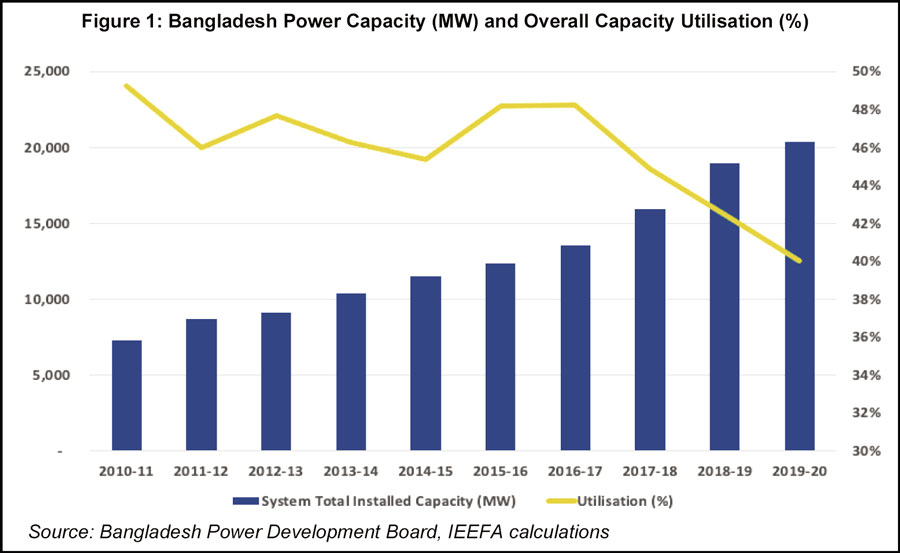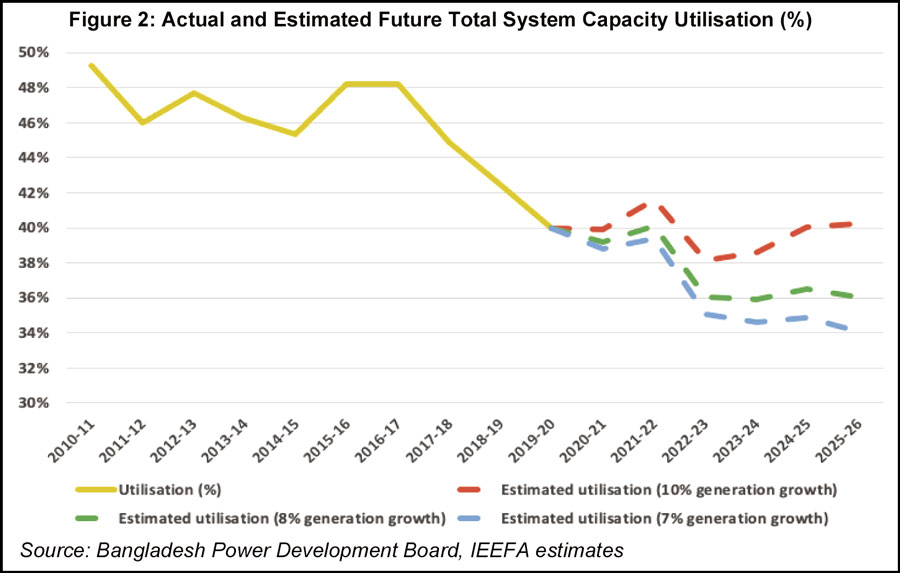The Bangladesh Power Development Board's (BPDB) latest annual report for the year 2020 reveals that the nation's overall power system utilisation has fallen again in FY20 to just 40.0 per cent, down from 43.0 per cent in the previous year (Figure 1). A figure of 40.0 per cent utilisation indicates significant surplus capacity within the power system.

With 2,000MW expected to have been added to the system by the end of 2020, this overcapacity will have worsened before the end of the year. Furthermore, in its new annual report, the BPDB discloses that 15,294MW of new power capacity is under construction and around 21,000MW will be added by the end of 2025. Over the same period, only 5,501MW of old capacity is to be retired.
As a result, under-utilisation - and hence, overcapacity - will worsen out to 2025 unless power generation growth recovers quickly and remains at a very high level throughout the period. Power generation growth was just 1.26 per cent in 2019-20 according to the BPDB, barely keeping pace with population growth, as the economic impacts of Covid-19 were felt in Bangladesh.
The Institute for Energy Economics and Financial Analysis (IEEFA) has estimated future capacity utilisation based on power generation growth assumptions and BPDB's disclosed capacity additions and retirements out to 2025. Even if generation growth immediately recovers to 10.0 per cent per annum in FY21 and remains at that level, overall capacity utilisation will drop below 40.0 per cent during the early 2020s before recovering back to just 40.0 per cent in 2025-26 (Figure-2).

If annual generation growth is 8.0 per cent, then utilisation will keep dropping down to 36.0 per cent by 2025-26. In the event that generation growth is 7.0 per cent, utilisation worsens even further to 34.0 per cent, meaning two-thirds of the nation's power capacity will sit idle across a full year (Figure-2).
With the global economic recovery from Covid-19 uncertain, Bangladesh risks seeing an already significant overcapacity situation worsen over the next five years if power generation growth does not recover to, and stay at, very high levels. Worsening overcapacity has significant implications for the BPDB's finances as well as power tariffs. Under power purchase agreements, thermal power generators receive capacity payments regardless of whether they are utilised or not. Capacity payments to power plants that increasingly sit idle raise the per unit cost of generation, which could result in the need for higher government subsidies to bail out BPDB's losses and/or the need to increase power tariffs for consumers.
Under new legislation recently passed, power tariffs can now be raised multiple time each year.
BPDB'S OPERATING LOSSES: BPDB made another very large operating loss as power continues to be sold at less than the cost of generation and purchase. The Tk.43.5 billion (US$514m) loss was lower than that of the previous year by 14.0 per cent. This was achieved by reduced reliance on oil- and diesel-fired power (Table-1) and lower power purchase from expensive rental plants. This helped lower the per unit fuel cost for thermal power plants by 16.0 per cent to Tk1.64/kWh.

Table-1 shows that utilisation of diesel- and oil-fired capacity reduced significantly compared to the previous year, particularly diesel which dropped from capacity utilisation of 16.8 per cent in FY19 to just 1.2 per cent in FY20. At the end of December 2020, diesel- and oil-fired power plants remained underutilised according to the BPDB.
As a result, the government subsidy needed to bail out BPDB from its significant annual losses was lower compared to the previous year, down 7.0 per cent to Tk74.4 billion ($880m).
However, going forward there is a significant risk that BPDB's losses - and the government subsidies needed to cover them - will increase. Increased losses and government subsidies would be unsustainable, significant power tariff increases would be the likely result.
The impact of overcapacity is one factor that could lead to larger losses. As noted above, capacity payments to plants increasingly sitting idle raises the per unit cost of power generation. On top of this, the planned future reliance on expensive imported coal and LNG will raise the per unit fuel cost for thermal power.
During the early 2020s, a wave of power projects fuelled by imported coal and LNG are scheduled to come on line to meet increasing demand and to replace retiring power plants. Where these replace oil- and diesel-fired power - Bangladesh's most expensive sources of power, they will lower the cost of generation, but where they replace domestic gas, they will be significantly more expensive and increase the cost.
Of the 5,501MW of capacity scheduled for retirement according to the BPDB's 2019-20 annual report, 3,604MW (66.0 per cent) is fuelled by domestic gas with 1,140MW (21.0 per cent) fuelled by diesel and 757MW (14.0 per cent) fuelled by oil.
Furthermore, there is still a significant amount of new, expensive oil-fired power generation set to come online which will add cost pressure onto the BPDB in addition to imported coal and LNG. More than 1,000MW of new oil-fired power is scheduled to be operative by the end of 2021 according to the BPDB.
The economic slump caused by Covid-19 lowered the cost of fossil fuels but prices are now on the rise again and already causing issues for Bangladesh. Several tenders for LNG imports have been cancelled due to concern over high prices during 2020. This concern is likely to intensify now that Asian LNG prices have risen to a two-year high.
NEED OF NEW POWER SYSTEM MASTER PLAN: A new Power System Master Plan (PSMP) is currently being prepared for release in 2021. It has been reported that overcapacity and fuel issues are amongst the priority issues to be addressed in the new plan.
It has also been reported that the Bangladesh government is considering cancelling the coal-fired power project pipeline due to the increasing difficulty in financing such projects and replacing them with LNG projects. However, replacing coal power capacity with similar capacities of LNG-fired capacity will not address the nation's overcapacity issue. Given Bangladesh's surplus capacity, and the cost of importing LNG, the government should cancel the coal power plants without replacing them with LNG. Similarly, import of expensive coal-fired power from Adani's Godda power plant in Jharkhand, India is also not required.
POTENTIAL FOR RENEWABLE ENERGY: Instead of replacing the coal power projects with LNG, the Bangladesh government should consider using the land set aside for these projects for renewable energy installations.
Utility-scale renewable energy has been slow to take off in Bangladesh, partly due to concerns over land availability. Using land already set aside for a fleet of coal-fired power plants could effectively jump-start Bangladesh's utility-scale solar and wind power build-out and push down renewable energy tariffs as happened in neighbouring India.
The Sustainable and Renewable Energy Development Authority's (SREDA) draft National Solar Energy Roadmap clearly suggests there are ways around Bangladesh's land constraints. SREDA's draft Roadmap recommends aiming for a high-deployment solar installation programme with a target of up to 30,000MW of solar to be installed by 2041.
SREDA sees 12,000MW of this 30,000MW target coming from rooftop solar. There is significant potential for rooftop solar in Bangladesh with the Infrastructure Development Company Ltd (IDCOL) calculating that 5,000MW could be installed on the rooftops of readymade garments, textiles and other industrial buildings. Similarly, it has been suggested that 2,000MW could be installed on the rooftops of government buildings. Rooftop solar capacities of this scale look entirely achievable given that Vietnam was able to add an astonishing 9,000MW of rooftop solar in 2020 as the global roll out of renewable energy accelerates.
Wind power should not be neglected. A 2018 U.S. National Renewable Energy Laboratory (NREL) study found Bangladesh had significantly more wind power potential than previously thought. A new wind power project to be built at Mongla was approved by the Cabinet Committee in December 2020.
A concerted renewable energy development programme would push down the cost of wind and solar in Bangladesh, as has been seen in countries around the world. Furthermore, a switch in focus from coal- and LNG-fired power to renewables can help address overcapacity by slowing down the per megawatt rate of capacity additions (wind and solar plants are smaller than typical coal- and LNG-fired projects).
The much faster construction times of wind and solar also make it easier to match capacity additions to power demand growth. The long and often delayed construction times of thermal power plants based on imported fossil fuels and their associated infrastructure make power regulators and governments dependent on long term demand forecasts which often turn out to be over-estimated. Such over-estimated long term forecasts are the basis for surplus power capacity additions.
TRANSMISSION AND DISTRIBUTION: Another key part of a successful response to Bangladesh's overcapacity problem would be investment in the transmission and distribution system.
Not only would this enable the installation of larger capacities of renewable energy, it would also help better utilise existing thermal power capacity. Currently, there are areas of Bangladesh that are poorly served with electricity whilst thermal power plants in other parts of the country stand largely unused. A switch in focus from thermal power capacity installation towards grid investment would make better use of Bangladesh's surplus capacity and see a reversal of the nation's declining capacity utilisation, thereby reducing the impact of capacity payments on the per unit cost of power.
Simon Nicholas is an energy finance analyst with The Institute for Energy Economics and Financial Analysis (IEEFA) in Australia. www.ieefa.org
© 2024 - All Rights with The Financial Express
